Science Meetings
2016 Ocean Sciences Meeting
February 21-26, 2016New Orleans, Louisiana USA
Website
The session,"Frontiers in Ocean Color Remote Sensing: Science and Challenges," was held during the Ocean Sciences Meeting (26-Feb-16). Advanced technologies and frequent, repeated, multi-scale satellite observations, in combination with field measurements, are essential for observing and predicting changes in Earth's ocean. Presentations explored the next generation of ocean science questions from ocean-observing satellites and challenges to those observations from science, technology, and modeling perspectives.Documents (16)
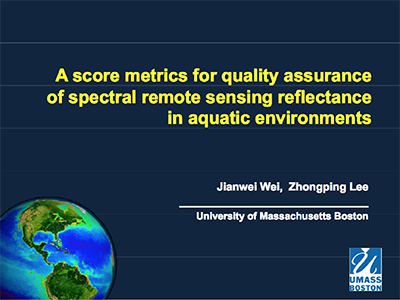
A Novel Scoring Metrics for Quality Assurance of Ocean Color Observations
Wei, J. (26-Feb-16). Interpretation of the ocean bio-optical properties from ocean color observations depends on the quality of the ocean color data, specifically the spectrum of remote sensing reflectance (Rrs). The in situ and remotely measured Rrs spectra are inevitably subject to errors induced by instrument calibration, sea-surface correction and atmospheric correction, and other environmental factors. Great efforts have been devoted to the ocean color calibration and validation. Yet, there exist no objective and consensus criteria for assessment of the ocean color data quality. In this study, the gap is filled by developing a novel metrics for such data quality assurance and quality control (QA/QC). 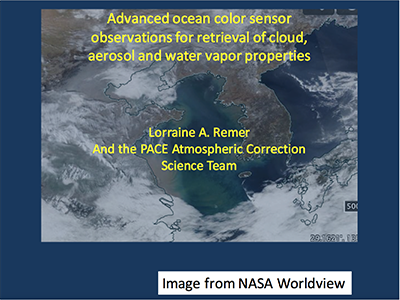
Advanced Ocean Color Sensor Observations for Retrieval of Cloud, Aerosol and Water Vapor Properties
Remer, L.A. (26-Feb-16). While the next generation of ocean color sensors offers enhanced capability to retrieve ocean parameters and to advance ocean science, these sensors also offer enhanced capability for observing atmospheric parameters, as well. In particular advanced ocean color sensors are expected to broaden the spectral range to include bands from the UV to the SWIR, inclusive on a single instrument that will observe aquatic, terrestrial and atmospheric targets with the same geometry, same spatial resolution, and similar calibration strategies across the entire spectrum. 
Advancing Ocean Remote Sensing with Spaceborne Lidar
Hostetler, C.A., Behrenfeld, M.J., Hair, J.W., Hu, Y., Powell, K.A., Scarino, A.J., Butler, C.F., Boss, E., Siegel, D., and Cetinić, I. (26-Feb-16). Global estimates of phytoplankton biomass (Cphyto) and particulate organic carbon (POC) have traditionally been made using passive ocean color measurements. Recently, data from the CALIOP sensor on the CALIPSO satellite have provided the first measurements of these two key carbon cycle stocks from a space-based lidar despite the fact that CALIOP was not designed for subsurface ocean retrievals. 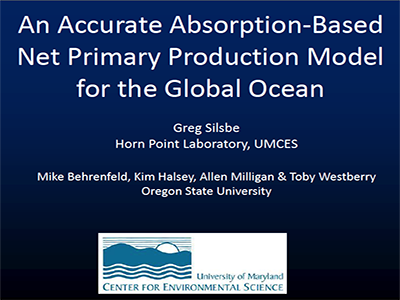
An Accurate Absorption-Based Net Primary Production Model for the Global Ocean
Silsbe, G., Westberry, T.K., Behrenfeld, M.J., Halsey, K., and Milligan, A. (26-Feb-16). As a vital living link in the global carbon cycle, understanding how net primary production (NPP) varies through space, time, and across climatic oscillations (e.g. ENSO) is a key objective in oceanographic research. The continual improvement of ocean observing satellites and data analytics now present greater opportunities for advanced understanding and characterization of the factors regulating NPP. 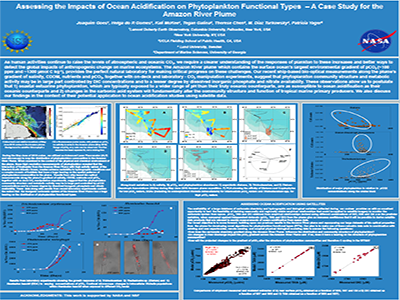
Assessing the Impacts of Ocean Acidification on Phytoplankton Functional Types from Space - A Case Study for the Amazon River Plume (Poster)
Goes, J.I., Gomes, H.R., McKee, K., Galina, T., Chen, T.L., Turkowsky, M.D., and Yager, P.L. (26-Feb-16). As human activities continue to raise the levels of atmospheric and oceanic CO2, we require a clearer understanding of the responses of plankton to these increases and better ways to detect the global impacts of anthropogenic change on marine ecosystems. 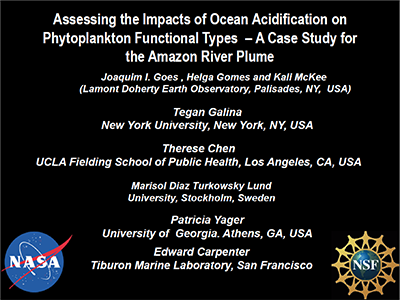
Assessing the Impacts of Ocean Acidification on Phytoplankton Functional Types from Space - A Case Study for the Amazon River Plume (Presentation)
Goes, J.I., Gomes, H.R., McKee, K., Galina, T., Chen, T.L., Turkowsky, M.D., and Yager, P.L. (26-Feb-16). As human activities continue to raise the levels of atmospheric and oceanic CO2, we require a clearer understanding of the responses of plankton to these increases and better ways to detect the global impacts of anthropogenic change on marine ecosystems. 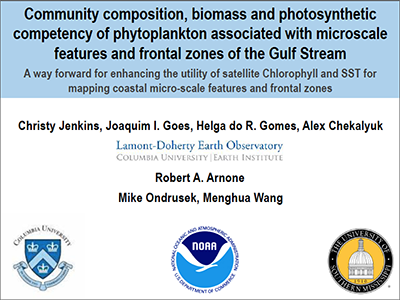
Community Composition, Biomass and Photosynthetic Competency of Phytoplankton Associated with Microscale Features and Frontal Zones of the Gulf Stream
Jenkins, C.A., Goes, J.I., Gomes, H.R., Chekalyuk, A.M., Arnone, R., and Tufillaro, N.B. (26-Feb-16). Frontal zones and microscale oceanographic features are easily observable from satellite measurements of SST and Chl a. Enhancing the utility of these space borne measurements for biological productivity, biogeochemical cycling and fisheries studies, will require novel bio-optical methods capable of providing information on the community structure, biomass and photo-physiology of phytoplankton, especially in regions where these smaller but prominent oceanographic features exist. 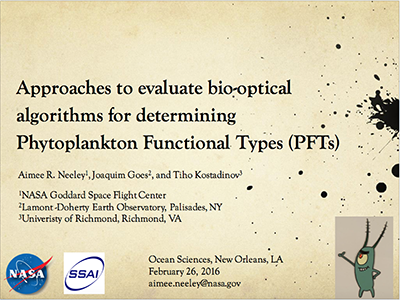
Evaluation of Bio-optical Models for Discriminating Phytoplankton Functional Types and Size Classes in Eastern U.S. Coastal Waters with Approaches to Remote Sensing Applications
Neeley, A.R., Goes, J.I., Jenkins, C.A., and Harris, L. (26-Feb-16). Phytoplankton species can be separated into phytoplankton functional types (PFTs) or size classes (PSCs; Micro-, Nano-, and Picoplankton). Bio-optical models have been developed to use satellite-derived products to discriminate PSCs and PFTs, a recommended field measurement for the future NASA PACE mission. 
Improving Methods for Assessing Reflectance Due to Whitecaps and Foam from Ocean Color Imagery
Dierssen, H.M., Randolph, K.L., Garaba, S.P. (26-Feb-16). The standard ocean color atmospheric correction algorithms have a simplistic method for treating whitecaps and foam that relies upon wind speed. However, large variability exists in the relationship between wind speed and whitecap coverage, as well as the amount of reflectance associated with whitecap and foam features. Here, field measurements of the Lambertian Equivalent Reflectance (LER) of whitecaps and foam made from the visible into the short wave infrared (350-2500 nm) are presented. 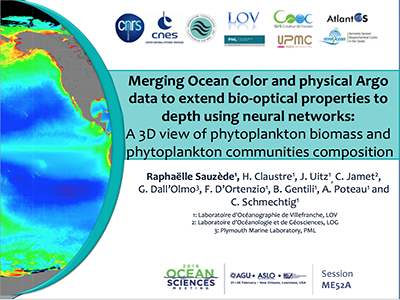
Merging Ocean Color and Physical Argo Data to Extend Bio-optical Properties to Depth Using Neural Networks: A Global 3D View of Phytoplankton Biomass and Phytoplankton Communities Composition
Sauzede, R., Claustre, H., Jamet, C., Uitz, J., Dall'Olmo, G., D'Ortenzio, F., Gentili, B., Poteau, A., and Schmechtig, C. (26-Feb-16). Ocean color observations enable the estimation of bio-optical proxies of phytoplankton biomass (e.g. chlorophyll a concentration, Chla, and particulate backscattering coefficient, bbp) in the surface layer of the ocean quasi-synoptically. In parallel, the Argo program distributes vertical profiles of the ocean physical properties with a global coverage and a high spatio-temporal resolution (every 10 days for ~3°x3° area). 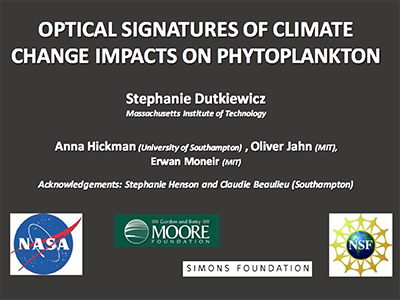
Optical Signatures of Climate Change Impacts on Phytoplankton
Dutkiewicz, S., Hickman, A.E., Jahn, O., and Moneir, E. (26-Feb-16). The ocean marine ecosystems will alter as a consequence of climate change, with ecological and biogeochemical ramifications. Here we use an earth system model which includes marine biogeochemistry and ecosystem, as well as important optical constituents such as coloured dissolved organic matter (CDOM), non-algal particles (NAP) as well as an optically diverse set of phytoplankton types. Importantly, the light field is spectrally resolved and the model outputs surface reflectance similar to that measured by ocean colour satellites. We study the trends over the 21st century in ecologically and biogeochemically important metrics such as primary production and plankton community structure, and in particular how these can be captured by reflectance and other optical characteristics. 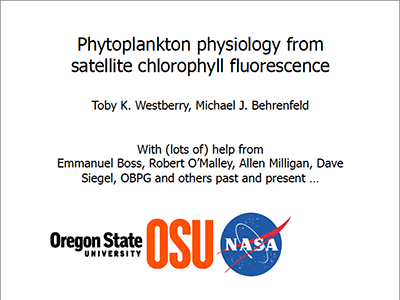
Phytoplankton Physiology from Satellite Chlorophyll Fluorescence
Westberry, T.K. and Behrenfeld, M.J. (26-Feb-16). Fluorescence from the chlorophyll pigment is the only unambiguous signal measured from satellite that can be exclusively attributed to phytoplankton. However, developing a comprehensive understanding of factors regulating satellite-derived fluorescence has been difficult. 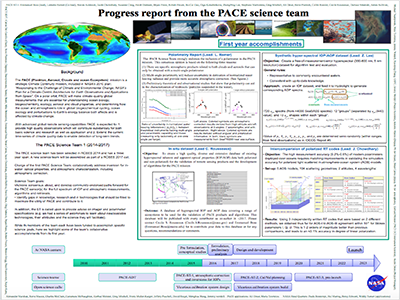
Progress Report From PACE’s Science Team
Boss, E. and Remer, L.A. (26-Feb-16). PACE, NASA's upcoming strategic climate continuity mission is due to launch in 2022. PACE will have a hyperspectral radiometer spanning from 350 to 800nm, several SWIR bands, and a polarimeter, allowing it to be used for studies of ocean biogeochemistry as well as to study clouds and aerosols distribution and microphysics. In anticipation to the launch, a Science Team was competed for and assembled who is tasked with working on algorithms to retrieve inherent optical properties and on atmospheric correction. 
Uncertainties in the Water-leaving Spectral Radiance Derived from Extrapolation of Near-surface Underwater Measurements
Li, L., Stramski, D., and Reynolds, R.A. (26-Feb-16). Extrapolation of near-surface underwater measurements is the most common method to estimate the water-leaving spectral radiance, Lw(λ) (where λ is the light wavelength in vacuum), and remote-sensing reflectance, Rrs(λ), for validation and vicarious calibration of satellite sensors, as well as for ocean color algorithm development. However, uncertainties in Lw(λ) arising from the extrapolation process have not been investigated in detail with regards to the potential influence of inelastic radiative processes such as Raman scattering and fluorescence. 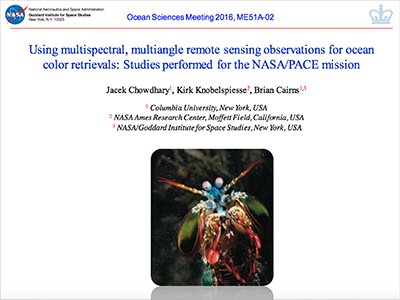
Using Multispectral, Multiangle Polarimetric Remote Sensing Observation for Ocean Color Retrievals: Studies Performed for the Pre-Aerosol, Clouds, and ocean Ecosystem (PACE) Mission
Chowdhary, J., Knobelspiesse, K.D., and Cairns, B. (26-Feb-16). The high sensitivity of polarized light scattered by suspended particles to the properties of these particles has successfully been exploited during the last 40+ years to obtain unique information of aerosols in planetary atmospheres from polarimetry. In addition, promising results have been obtained regarding the sensitivity of polarimetric observations to the properties of marine particulates. This has led to the consideration of adding a polarimeter to the PACE mission. Here, we discuss 3 types of polarization studies performed for this mission. 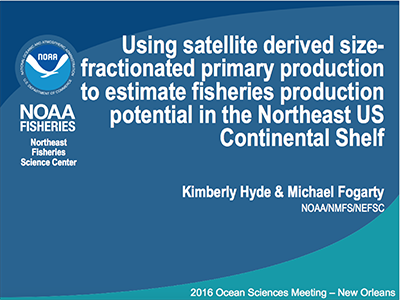
Using Satellite Derived Size-fractionated Primary Production Estimates to Estimate Fisheries Production Potential in the Northeast US Continental Shelf
Hyde, K. and Fogarty, M.J. (26-Feb-16). Advances in satellite derived phytoplankton size class and functional type models have broadened the fisheries application possibilities of ocean color remote sensing. Here we partition phytoplankton biomass and primary production into microplankton and nano-picoplankton size classes for use in a bottom-up approach to estimate fisheries production and exploitation rate potentials. 
